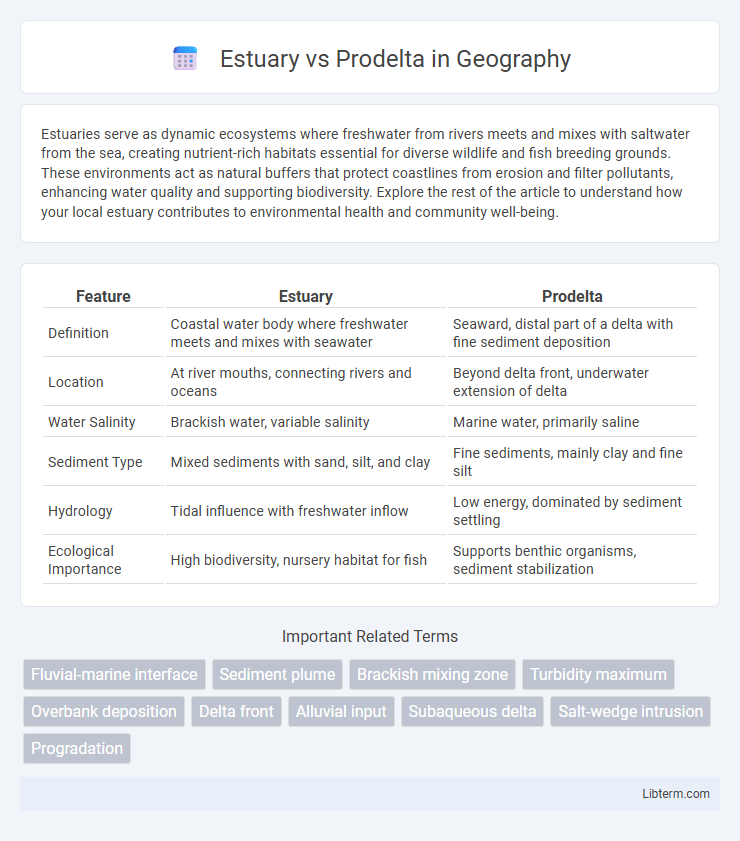Estuaries serve as dynamic ecosystems where freshwater from rivers meets and mixes with saltwater from the sea, creating nutrient-rich habitats essential for diverse wildlife and fish breeding grounds. These environments act as natural buffers that protect coastlines from erosion and filter pollutants, enhancing water quality and supporting biodiversity. Explore the rest of the article to understand how your local estuary contributes to environmental health and community well-being.
Table of Comparison
| Feature | Estuary | Prodelta |
|---|---|---|
| Definition | Coastal water body where freshwater meets and mixes with seawater | Seaward, distal part of a delta with fine sediment deposition |
| Location | At river mouths, connecting rivers and oceans | Beyond delta front, underwater extension of delta |
| Water Salinity | Brackish water, variable salinity | Marine water, primarily saline |
| Sediment Type | Mixed sediments with sand, silt, and clay | Fine sediments, mainly clay and fine silt |
| Hydrology | Tidal influence with freshwater inflow | Low energy, dominated by sediment settling |
| Ecological Importance | High biodiversity, nursery habitat for fish | Supports benthic organisms, sediment stabilization |
Introduction to Estuaries and Prodelta
Estuaries are dynamic coastal zones where freshwater from rivers meets and mixes with saltwater from the ocean, creating unique brackish water environments with high biological productivity. Prodelta refers to the underwater extension of a delta, characterized by fine sediment deposition further offshore, which influences sediment distribution and nutrient cycling in marine ecosystems. Understanding estuaries and prodelta regions is vital for managing coastal biodiversity, fisheries, and sediment transport processes.
Defining Estuary: Key Features
An estuary is a partially enclosed coastal body of water where freshwater from rivers and streams meets and mixes with saltwater from the ocean, creating a unique brackish water environment. Key features of an estuary include tidal fluctuations, nutrient-rich sediments, and high biological productivity that supports diverse plant and animal species. Estuaries serve as critical nurseries for many marine organisms and act as natural filters that improve water quality.
Understanding Prodelta: Main Characteristics
The prodelta is the underwater, low-gradient zone located seaward of the delta front, characterized by fine-grained sediments such as silts and clays settling slowly from suspension. This environment experiences low-energy conditions compared to estuaries, promoting sediment accumulation that forms thick, stratified deposits crucial for delta growth. Prodelta sediments often display distinct layering and geochemical signatures, reflecting the interplay between marine and fluvial influences in coastal depositional systems.
Formation Processes in Estuaries vs Prodelta
Estuaries form through the mixing of freshwater from rivers and seawater, creating dynamic environments influenced by tides, waves, and sediment deposition from both terrestrial and marine sources. Prodelta areas develop seaward of the delta front, accumulating fine-grained sediments like clay and silt largely delivered by river discharge, slowly settling in quieter, deeper waters. Sediment sorting in estuaries is more complex due to fluctuating salinity and hydrodynamic conditions, whereas prodelta sediments show more consistent layering from gradual settling in low-energy zones.
Sediment Dynamics in Estuary and Prodelta Zones
Sediment dynamics in estuary zones are characterized by complex interactions between tidal currents, riverine discharge, and wave action, leading to sediment deposition and erosion patterns that shape the estuarine morphology. Prodelta zones experience fine sediment settling from suspended loads, influenced primarily by flocculation and settling velocity in a relatively low-energy environment, promoting thick mud accumulation. Understanding these contrasting sediment transport and deposition mechanisms is critical for predicting estuarine evolution and managing coastal sediment budgets.
Ecological Significance: Estuary Compared to Prodelta
Estuaries serve as critical transitional zones where freshwater meets seawater, fostering unique brackish habitats that support diverse species and act as nurseries for many marine organisms. Compared to the prodelta, which primarily accumulates sediments and organic material offshore, estuaries have higher ecological productivity and function as natural filters that improve water quality by trapping pollutants and nutrients. These features make estuaries essential for maintaining biodiversity, supporting fisheries, and protecting coastal ecosystems from erosion and habitat loss.
Water Chemistry Differences
Estuaries exhibit variable salinity levels due to the mixing of freshwater and seawater, resulting in higher nutrient concentrations and dynamic dissolved oxygen levels compared to prodelta environments. Prodelta zones, located offshore from river mouths, typically have more stable salinity but elevated concentrations of fine sediments and organic matter that influence redox potential and nutrient cycling in the benthic layer. The distinct biogeochemical gradients in estuaries and prodelta areas drive differences in pH, salinity, and nutrient availability, shaping unique aquatic ecosystems.
Human Impacts on Estuary and Prodelta Environments
Human impacts on estuary and prodelta environments include nutrient pollution, habitat destruction, and sedimentation changes that disrupt ecological balance. Estuaries face increased contamination from industrial runoff, urban development, and wastewater discharges, leading to eutrophication and loss of biodiversity. Prodelta zones experience altered sediment deposition due to dam construction and dredging, which negatively affects benthic habitats and coastal resilience.
Case Studies: Examples of Estuaries and Prodelta Regions
The Chesapeake Bay estuary exemplifies a dynamic estuarine environment where freshwater from rivers mixes with ocean saltwater, supporting diverse ecosystems and economic activities. In contrast, the Mississippi River prodelta showcases extensive sediment deposition creating rich, nutrient-laden marine habitats crucial for fisheries and coastal protection. Studies of the Amazon estuary and Nile prodelta reveal variations in sediment transport and biodiversity linked to river discharge patterns and coastal geomorphology.
Conclusion: Key Differences Between Estuary and Prodelta
Estuaries serve as dynamic transition zones where freshwater mixes with seawater, creating highly productive and biologically diverse environments, while prodelta regions are deeper offshore areas where fine sediments accumulate, forming distinct depositional layers. The key differences lie in hydrodynamics, sediment types, and ecological functions: estuaries exhibit strong tidal mixing and nutrient cycling supporting diverse habitats, whereas prodelta zones experience sediment settling with limited water movement and support less biological activity. Understanding these distinctions is crucial for coastal management, sediment transport studies, and preserving aquatic ecosystems.
Estuary Infographic

 libterm.com
libterm.com